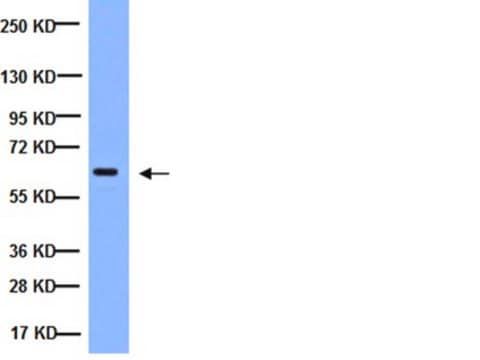MAB3026
Anti-NFκB Antibody, p65 subunit, active subunit, clone 12H11
clone 12H11, Chemicon®, from mouse
Manufacturer: Sigma Aldrich
Synonym(S): Rel A
Select a Size
| Pack Size | SKU | Availability | Price |
|---|---|---|---|
| 25 μG | MAB3026-25-μG | In Stock | ₹ 13,730.00 |
| 100 μG | MAB3026-100-μG | In Stock | ₹ 49,099.99 |
MAB3026 - 25 μG
In Stock
Quantity
1
Base Price: ₹ 13,730.00
GST (18%): ₹ 2,471.40
Total Price: ₹ 16,201.40
biological source
mouse
Quality Level
100
antibody form
purified immunoglobulin
antibody product type
primary antibodies
clone
12H11, monoclonal
species reactivity
human, rabbit, rat
species reactivity (predicted by homology)
mouse
packaging
antibody small pack of 25 μg
manufacturer/tradename
Chemicon®
technique(s)
electrophoretic mobility shift assay: suitableflow cytometry: suitableimmunocytochemistry: suitableimmunofluorescence: suitableimmunohistochemistry (formalin-fixed, paraffin-embedded sections): suitablewestern blot: suitable
Description
- General description: The transcription factor NFkappaB (Nuclear Factor kappa B) is involved in the expression and regulation of a number of important cellular and physiological processes such as growth, development, apoptosis, immune and inflammatory response, and activation of various viral promoters including human immunodeficiency virus long terminal repeats. NFkappaB represents a group of structurally related and evolutionarily conserved proteins related to the proto-oncogene c-Rel with five members in mammals that include Rel (cRel), RelA (p65), RelB, NFkappaB1 (p50 and its precursor p105), and NFkappaB2 (p52 and its precursor p100). NFkappaB/Rel proteins exist as homo- or heterodimers to form transcriptionally competent or repressive complexes. Although most NFkappaB dimers are activators of transcription, the p50/50 and p52/52 homodimers can repress the transcription of their target genes. The p50/p65 heterodimer of NFkappaB is the most abundant in cells.
- Specificity: Recognizes an epitope overlapping the nuclear location signal (NLS) of the p65 subunit of the NFkB heterodimer. Thus it selectively binds to the activated form of NFkB (Zabel et al., 1993). The antibody can also be used for electrophoretic mobility supershift assays (EMSA). The nuclear factor kB (NFkB) is a sequence-specific DNA-binding protein (Sen & Baltimore, 1986). It is a pleiotropic transcription factor which is involved in the expression of a variety of cellular and viral genes (Lenardo & Baltimore, 1989). NFkB consists of two subunits which are named according to their molecular weight, p50 and p65 (Kawakami et al., 1988). The subunits are stabilized by a so-called inhibitory chain IkB (Baeuerle & Baltimore, 1988). In quiescent cells, NFkB resides in the cytosol in an inactive form which can be activated in vivo by treatment of cells with cytokines or protein kinase activators. In vitro, it is possible to generate the active form of NFkB by treatment with sodium deoxycholate, formadine or electrophoretic size fractionation. The active form of NFkB is a heterotetrameric protein, consisting of the two p50 and two p65 subunits (Lenardo et al., 1987). After activation NFkB translocates from the cytosol to the nucleus of the cell, binds to specific DNA sequences and initiates transcription.
- Immunogen: Epitope: p65 subunit, active subunit
- Application: Immunofluorescence: A 1-10 μg/mL concentration of a previous lot was used in immunofluorescence.Immunohistochemistry (paraffin sections): A 5-10 μg/mL (APAAP) concentration of a previous lot was used in immunohistochemistry.Immunohistochemistry (frozen sections): A 5-10 μg/mL (APAAP) concentration of a previous lot was used in immunohistochemistry.Immunohistochemistry: The clone 12H11 works best in fresh frozen or acetone fixed human tissues, however some groups have had reactivity in traditional formalin fixed tissue when the tissue is of human origin. It is recommended that ABC or enhanced detection systems be employed for the best visualization in either acetone or formalin fixed tissues. The antibody reacts with human tissues best. Rat tissue will also react but at a lower affinity, and the antibody does not react with mouse, other species have not been examined. Microwave citric acid buffer or trypsin digestion antigen recovery have both been successful with 12H11 on formalin fixed tissues. Western blot: 5-10 µg/mL (ECL) Electrophoretic Mobility Supershift Assay: A 0.5-1 μg/mL concentration of a previous lot was used in Supershift assay.Flow cytometry: A previous lot of this antibody was used in flow cytometry. Fixed cells only, acetone fixed cells.Optimal working dilutions must be determined by end user.
- Quality: Routinely evaluated by Western Blot on PC12 lysates.Western blot: 1:500 dilution of this lot detected NF KAPPA B, P65 on 10 μg of PC12 lysates.
- Target description: 65 kDa
- Physical form: Format: Purified
- Storage and Stability: Stable for 6 months at 2-8ºC from date of receipt. Aliquot to avoid repeated freezing and thawing. For maximum recovery of product, centrifuge the original vial after thawing and prior to removing the cap.
- Analysis Note: ControlTNF α-treated HeLa cells, PMA and calcium ionophore-treated Jurkat cells.
- Other Notes: Concentration: Please refer to the Certificate of Analysis for the lot-specific concentration.
- Legal Information: CHEMICON is a registered trademark of Merck KGaA, Darmstadt, Germany
- Disclaimer: Unless otherwise stated in our catalog or other company documentation accompanying the product(s), our products are intended for research use only and are not to be used for any other purpose, which includes but is not limited to, unauthorized commercial uses, in vitro diagnostic uses, ex vivo or in vivo therapeutic uses or any type of consumption or application to humans or animals.
Compare Similar Items
Show Difference
biological source: mouse
Quality Level: 100
antibody form: purified immunoglobulin
antibody product type: primary antibodies
clone: 12H11, monoclonal
species reactivity: human, rabbit, rat
species reactivity (predicted by homology): mouse
packaging: antibody small pack of 25 μg
manufacturer/tradename: Chemicon®
technique(s): electrophoretic mobility shift assay: suitableflow cytometry: suitableimmunocytochemistry: suitableimmunofluorescence: suitableimmunohistochemistry (formalin-fixed, paraffin-embedded sections): suitablewestern blot: suitable
biological source:
mouse
Quality Level:
100
antibody form:
purified immunoglobulin
antibody product type:
primary antibodies
clone:
12H11, monoclonal
species reactivity:
human, rabbit, rat
species reactivity (predicted by homology):
mouse
packaging:
antibody small pack of 25 μg
manufacturer/tradename:
Chemicon®
technique(s):
electrophoretic mobility shift assay: suitableflow cytometry: suitableimmunocytochemistry: suitableimmunofluorescence: suitableimmunohistochemistry (formalin-fixed, paraffin-embedded sections): suitablewestern blot: suitable


